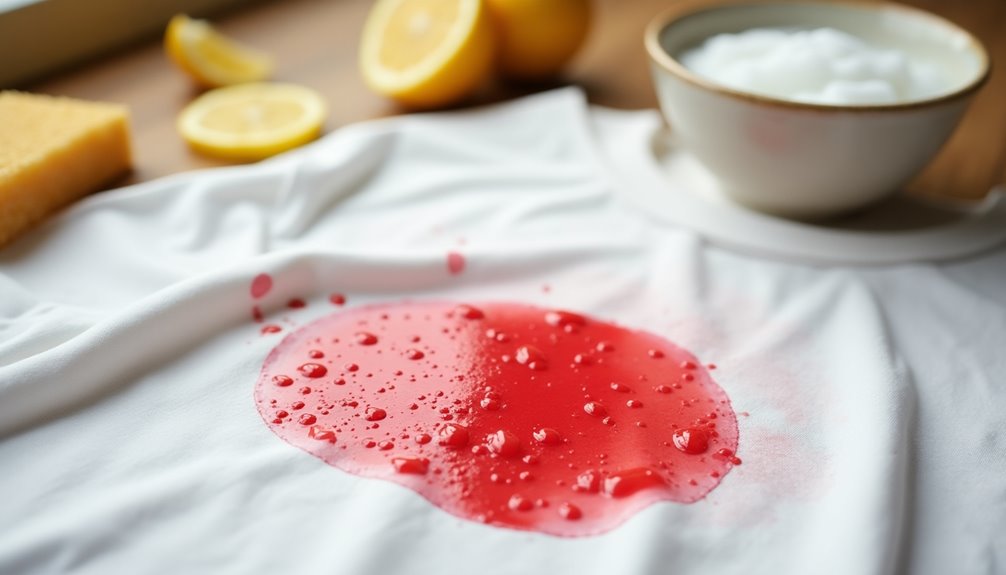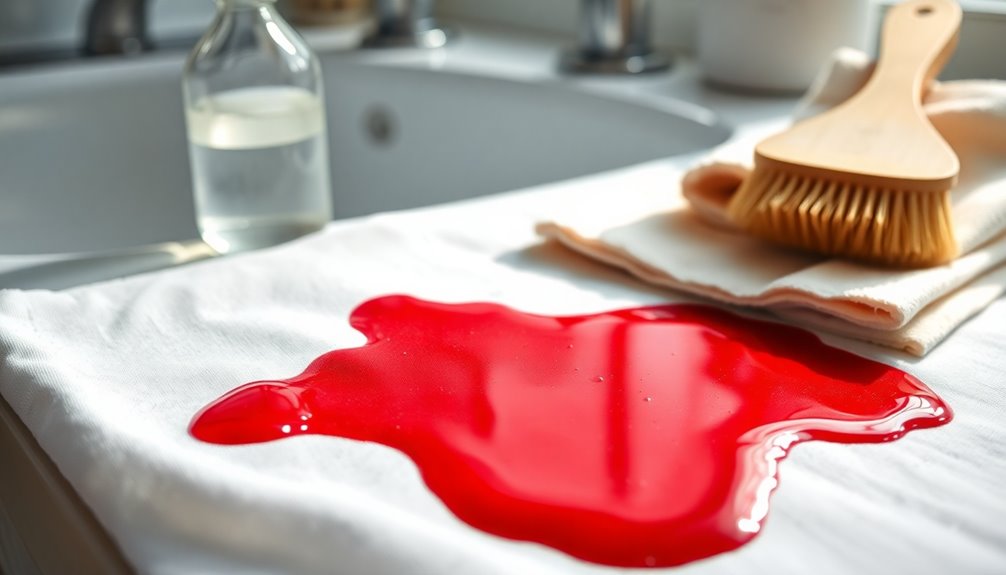To get red juice out of clothes, act quickly! Rinse the stain under cold water immediately to dilute it. Then, apply liquid detergent directly onto the stain and gently rub it for five minutes. For stubborn stains, soak the fabric in a mix of white vinegar and detergent for 15-30 minutes. Afterward, wash according to the care label and check for any remaining stains before drying. There's more to mastering stain removal, so keep going to learn the best techniques!
Key Takeaways
- Rinse the stained fabric under cold water immediately to dilute the red juice before it sets in.
- Apply liquid detergent directly onto the stain and gently rub it in for about five minutes.
- For tougher stains, soak the garment in a mixture of equal parts white vinegar and laundry detergent for 15 to 30 minutes.
- Wash the garment in the hottest safe setting according to the care label, checking for stain removal afterward.
- If the stain remains, repeat the soaking and washing process, avoiding drying until the stain is fully removed.

Red juice stains can be a nightmare, especially when they land on your favorite clothes. You might feel panic rising as that vibrant red pigment seeps into the fabric, but don't worry! You can tackle the stain effectively if you act quickly. The key is to dilute the stain before it sets in. Grab your garment and head to the nearest sink. Rinse the red stain under cold water as soon as possible. This helps flush out some of the juice and keeps the pigment from embedding deeper into the fibers.
Once you've rinsed the stain, it's time to bring in the heavy artillery—your liquid detergent. Apply a generous amount of a stain remover, like Tide HE Turbo Clean, directly onto the stain. Gently rub it in, allowing it to penetrate the fabric for about five minutes. After that, rinse the area with cold water again. This step is crucial because it helps lift the stain further.
If you still see traces of that pesky red juice, you may need to escalate your efforts. For tougher stains, you can create a soaking solution. Mix equal parts white vinegar and laundry detergent in a bowl filled with cold water. Submerge the affected clothing in this mixture and let it soak for 15 to 30 minutes. The vinegar acts as a natural stain remover, while the detergent works to break down the juice's pigments.
After soaking, rinse the garment thoroughly in cold water to remove the solution and any loosened residue. Now that you've given the stain a solid fighting chance, it's time to wash the clothing. Always check the care label for the hottest safe setting. Washing your garment on a higher temperature can help ensure that the stain is completely removed.
Once the wash cycle is complete, inspect the clothing carefully. If the red stain persists, don't dry the garment just yet. Drying can set the stain, making it nearly impossible to remove later. Instead, repeat the soaking and washing process until you're satisfied that the stain is gone.
If you follow these steps diligently, you'll find that removing red juice stains doesn't have to be a daunting task. The quicker you act, the better your chances of saving your favorite outfit. Remember, it's all about dilution, the right products, and persistence. With a little effort and the right techniques, you can conquer those stains and keep your clothing looking fresh and clean.
Frequently Asked Questions
Does Red Juice Come Out of Clothes?
Yes, red juice can come out of clothes if you act quickly and use the right techniques.
Start by flushing the stain with cold water to dilute it. Then, pre-treat the area with a suitable detergent for about five minutes.
Wash the garment in the hottest water safe for the fabric. If you still see the stain after washing, don't dry it; repeat the process until it's completely removed.
How to Get Red Liquid Out of Clothes?
Did you know that nearly 50% of people have faced stubborn stains on their clothes?
When you're dealing with red liquid stains, act fast! Flush the stain with cold water from the back of the fabric to prevent it from setting.
Apply liquid laundry detergent directly to the stain and let it sit for five minutes.
For tougher stains, soak it in a mix of cold water and vinegar. Rinse and wash as usual!
How to Remove Red Juice Stains?
To remove red juice stains, start by blotting the area with a clean cloth to soak up excess liquid—don't rub it.
Rinse the stain under cold running water from the back to push the juice out.
Next, apply liquid laundry detergent directly to the stain and let it sit for five minutes.
For tougher stains, soak the garment in cold water mixed with white vinegar for 30 minutes before washing as usual.
How to Get Red Cherry Juice Out of Clothes?
To get red cherry juice out of your clothes, start by flushing the stain with cold water from the back of the fabric. This helps dilute the juice.
Next, mix one tablespoon of dishwashing detergent, one tablespoon of white vinegar, and two cups of cold water. Soak the stained fabric for 15-20 minutes.
For tough stains, dab with rubbing alcohol, then rinse. Finally, wash the garment according to its care label instructions.
Conclusion
Now that you know how to tackle that pesky red juice stain, it's time to put your newfound skills to the test. Just like your trusty smartphone helps you navigate life, a few simple steps can help you navigate those laundry challenges. Remember, acting quickly is key! So grab your cleaning supplies and show those stains who's boss. With a little effort, your clothes will be looking fresh and vibrant again, ready for whatever adventure comes next!
Cindy thoroughly researches juicing trends, techniques, and recipes to provide readers with practical advice and inspiration. Her writing style is accessible, engaging, and designed to make complex concepts easy to understand. Cindy’s dedication to promoting the advantages of juicing shines through her work, empowering readers to make positive changes in their lives through the simple act of juicing.











